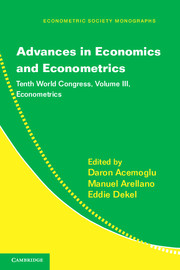Book contents
- Frontmatter
- Contents
- Contributors
- Preface
- I ECONOMETRICS OF INDUSTRIAL ORGANIZATION
- II MACROECONOMETRICS
- 4 Macroeconomics and Volatility: Data, Models, and Estimation
- 5 Estimation and Evaluation of DSGE Models: Progress and Challenges
- 6 Discussion of Fernández-Villaverde and Rubio-Ramírez as well as Schorfheide
- III ECONOMETRIC THEORY
- IV EMPIRICAL MICROECONOMICS
- V TIME SERIES AND PANELS
- VI MIRRLEES REVIEW: RETHINKING THE TAX SYSTEM FOR THE TWENTY-FIRST CENTURY
- Name Index
- Miscellaneous Endmatter
6 - Discussion of Fernández-Villaverde and Rubio-Ramírez as well as Schorfheide
Published online by Cambridge University Press: 05 May 2013
- Frontmatter
- Contents
- Contributors
- Preface
- I ECONOMETRICS OF INDUSTRIAL ORGANIZATION
- II MACROECONOMETRICS
- 4 Macroeconomics and Volatility: Data, Models, and Estimation
- 5 Estimation and Evaluation of DSGE Models: Progress and Challenges
- 6 Discussion of Fernández-Villaverde and Rubio-Ramírez as well as Schorfheide
- III ECONOMETRIC THEORY
- IV EMPIRICAL MICROECONOMICS
- V TIME SERIES AND PANELS
- VI MIRRLEES REVIEW: RETHINKING THE TAX SYSTEM FOR THE TWENTY-FIRST CENTURY
- Name Index
- Miscellaneous Endmatter
Summary
The Philadelphia School of Empirical Macroeconomics
As a tourist to Philadelphia, I visited the halls where the Constitution of the United States of America was drafted. George Washington then sat on a chair with an engraving, showing half a sun, perhaps just over the horizon. When agreement was finally reached, Benjamin Franklin is reported to have remarked, “I have often looked at that picture behind the president without being able to tell whether it was a rising or setting sun. Now at length I have the happiness to know that it is indeed a rising, not a setting sun.”
It is probably not appropriate to use such an important event in the history of the United States to lead into the discussion of papers written by economists, however important these papers or these economists may be. However, reading these papers, I simply could not get this story out of my head. In addition, two of these authors are at the University of Pennsylvania in Philadelphia, after all. Do these papers signify the rising sun or a setting sun of a Philadelphia school of empirical macroeconomics (with Rubio-Ramirez at Duke not too far away to justify that label)? That school can perhaps be described by the following approach:
Evaluate macroeconomic questions quantitatively.
Use Dynamic Stochastic General Equilibrium (DSGE) models.
Higher-order effects may matter. Therefore, solve the models, using higher-order solution techniques. Lower-order techniques may not be appropriate.
Estimate the models using Bayesian techniques. Dynare provides a good implementation, with the frontier exploring further important extensions, such as those described in these papers.
For nonlinear models, use nonlinear particle-filtering techniques for estimation.
- Type
- Chapter
- Information
- Advances in Economics and EconometricsTenth World Congress, pp. 231 - 242Publisher: Cambridge University PressPrint publication year: 2013



